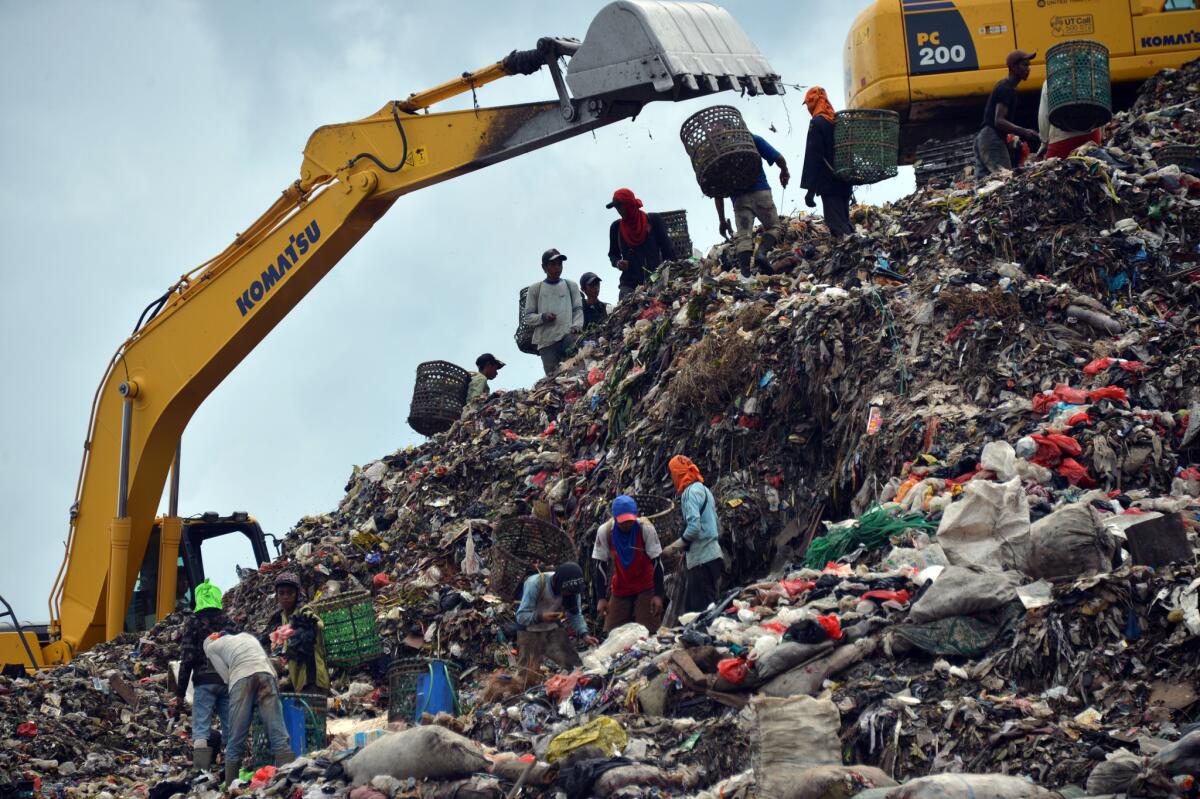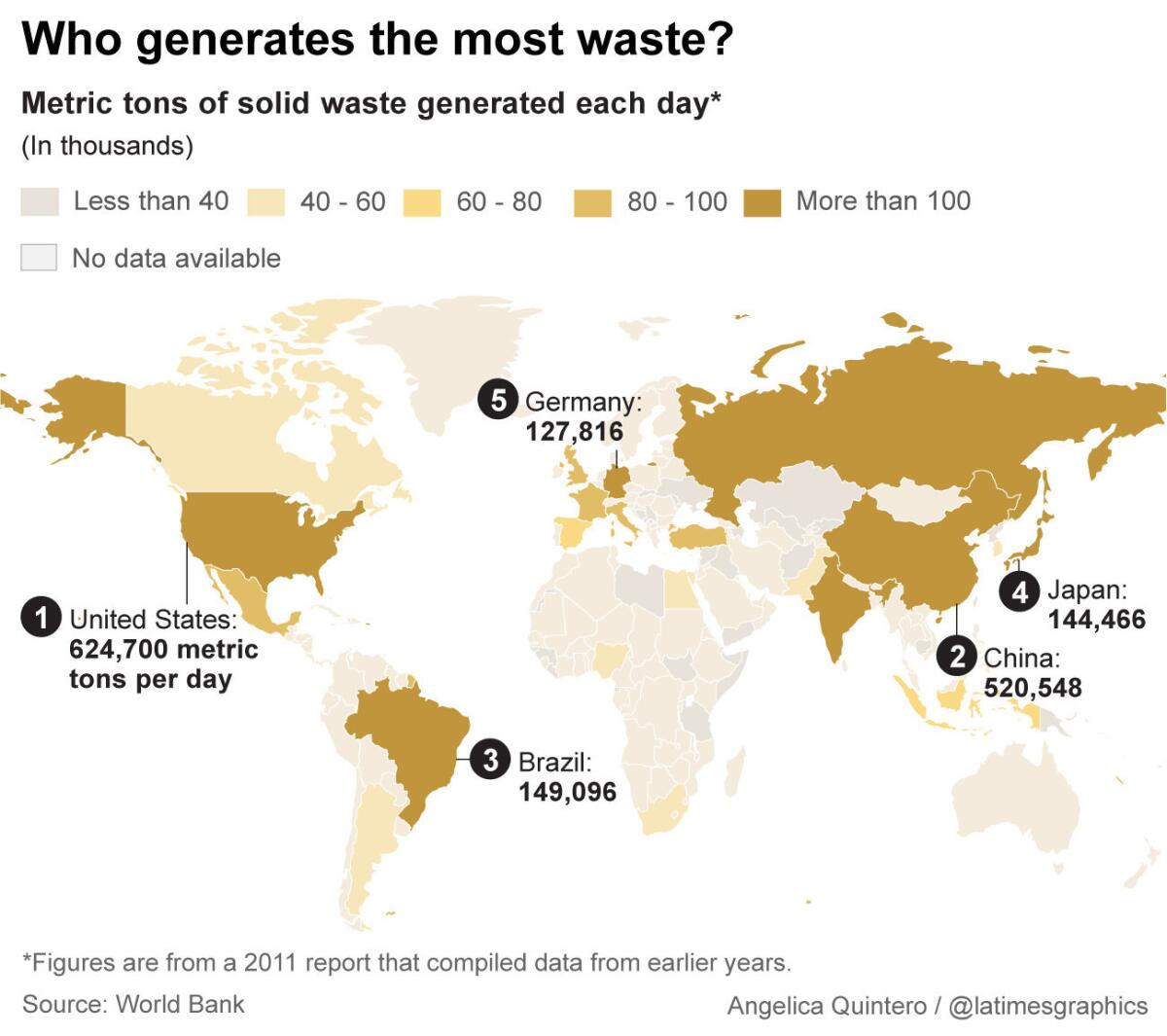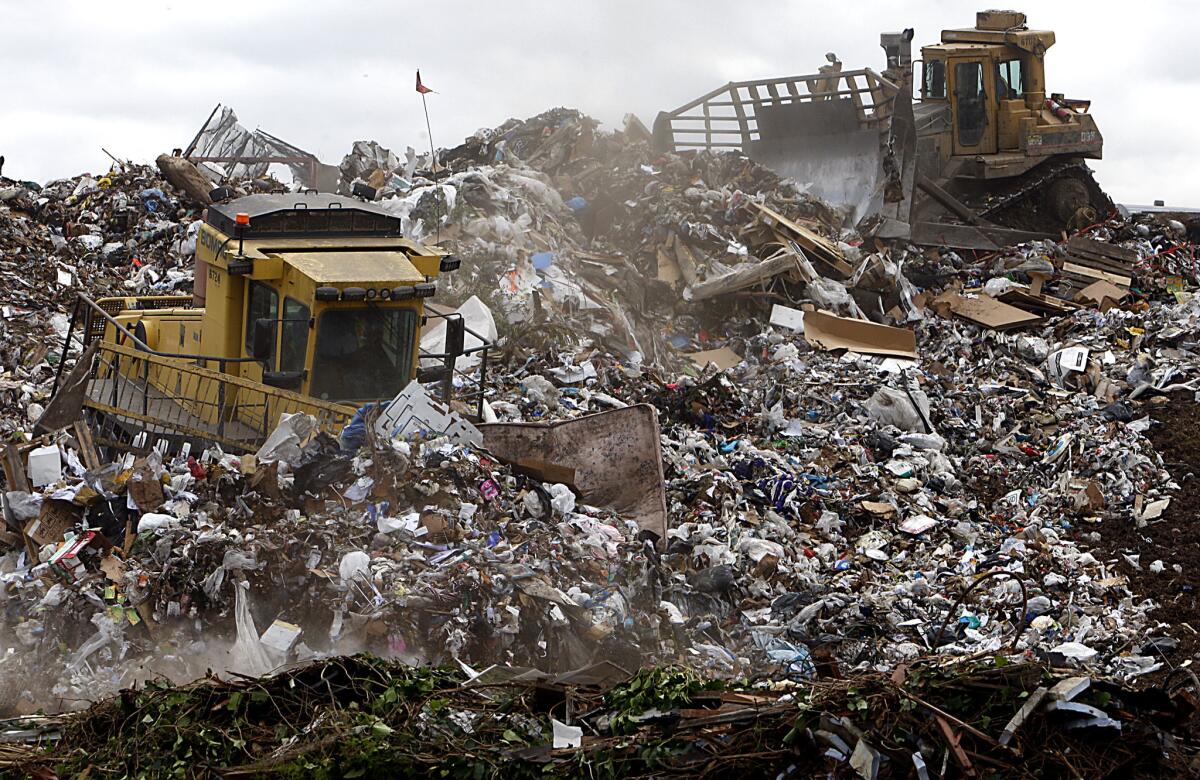The world’s trash crisis, and why many Americans are oblivious

- Share via
As nations around the globe observe Earth Day, one of the most daunting issues facing the world is the mounting waste problem, which impairs public health, pollutes the environment and threatens to drown some poor countries in toxicity.
More than half the world’s population does not have access to regular trash collection, a grim statistic given the amount of garbage produced globally.
Some experts say the globe’s trash troubles are at a crisis level. Here are a look at the problem and some possible solutions:
See the most-read stories this hour >>
What is the scope of the waste problem?
Each year, nations generate 1.3 billion tons of waste. That’s expected to soar to 4 billion tons by 2100, according to Ede Ijjasz-Vasquez, senior director for the World Bank's Social, Urban, Rural and Resilience Global Practice.
The United States, China, Brazil, Japan and Germany are the leading trash generators. The U.S. produced about 228 million tons of waste in 2006, a figure that climbed to 254 tons by 2013. China (with a population around four times larger than that of the U.S.) is close behind, with 190 million tons of waste per year.
The more urbanized and industrialized a country becomes, the more trash it produces, Ijjasz-Vasquez said. The United Nations Environment Program predicts the amount of waste will probably double in lower-income African and Asian cities as a result of population growth, urbanization and rising consumption.

“There is no end in sight to this trend,” the U.N. agency says. “Public waste systems in cities cannot keep pace with urban expansion; rapid industrialization is happening in countries that have not yet developed the appropriate systems to deal with hazardous and special wastes.”
Ijjasz-Vasquez said developing nations tend to spend more on collection than on disposal, but collection is still not efficient. South Asia and Africa have the lowest level of efficient waste collection, according World Bank statistics.
Join the conversation on Facebook >>
Why are many Americans oblivious to being serial waste generators?
“Because we’re not seeing it, we think it’s not a problem,” said Mark Dancy, president of WasteZero, one of the nation’s largest waste reduction companies.
Unlike most utilities, such as gas, water and electricity, that are charged depending on how much is used, it works differently for waste.
Because most cities and towns charge a flat fee for trash service or include it within the property tax, most Americans pay little attention to the amount of waste they are discarding, he said.

“By taking our waste away from us so efficiently, it makes us more inclined to dispose more,” said Joshua Reno, an assistant professor of anthropology at Binghamton University, who studies trash.
Reno, who spent a year working as a paper picker at a mega-landfill on the outskirts of Detroit exploring our relationship with garbage, said that although the country has no shortage of space for its trash, even the best-run landfills can stress the environment.
Unregulated or illegal dumpsites serve about 4 billion people and hold more than 40% of the waste worldwide, according to the World Bank.
What are the threats and ramifications of the global trash problem?
The threat of waste to the environment, health and safety is huge. And so are the financial and social ramifications, waste experts say.
Pollution runs into rivers and seeps into ground water. Flooding is caused by garbage clogging drains, and the atmosphere can be poisoned by the toxic discharge from trash.
When waste is not collected, the frequency of illness such as diarrhea doubles and acute respiratory infection — linked to the burning of waste — is six times higher, Ijjasz-Vasquez said.
In less developed nations, uncollected waste is typically heaviest near less affluent neighborhoods and slums. For scavengers, discarded food in the heaps of trash provides sustenance and a livelihood.

At the same time, those who forage through the dumps expose themselves to hazards such as lead and mercury and infectious agents.
Trash also causes a financial burden. Cities in developing countries spend 20% to 50% of their budgets dealing with waste management, a hardship for cash-strapped nations, Ijjasz-Vasquez said.
In the U.S., about $200 billion a year is spent on solid waste management and lost energy resources from disposing trash, according to Dancy.
So what’s the solution?
“Many people think it is just about getting an incinerator and it’s all fixed,” said Ijjasz-Vasquez. “This is part of the solution, but technical and engineering solutions are not a silver bullet.”
The key is ensuring the waste actually gets collected for disposal, Ijjasz-Vasquez said. “You can’t do anything if you have a fancy landfill and there’s no way to get the waste there.”
Changing behavior so that people and societies are encouraged to reduce and recycle waste is also crucial.
Since 2000, the World Bank has contributed about $4.5 billion to support 329 solid waste programs around the globe. They include projects such as basic trash collection and disposal, reuse and recycling, and initiatives aimed at changing habits related to waste.
In some countries, informal waste workers have been given formal employment opportunities in waste management.
In the United States, where recycling programs have been operating in full force for years, some experts believe the answer to reducing waste lies in charging for its disposal by weight or other metrics.
WasteZero promotes a bag-based “pay-as-you-throw” program. Used in more than 800 cities and counties across the country, the program charges residents a set fee in cash for each bag they dispose of at a drop-off location.
The program has resulted in an average waste reduction of 44% and often doubles recycling rates, according to WasteZero’s statistics.
“When you charge for something, people use less of it, and in this case it’s less trash,” Dancy said.
ALSO
Happy Earth Day! 6 places to celebrate in California this weekend
The Paris climate accord is about to be signed. Here's what happens next
Obama's environmental agenda faces obstacles at home
Sign up for Essential California
The most important California stories and recommendations in your inbox every morning.
You may occasionally receive promotional content from the Los Angeles Times.








